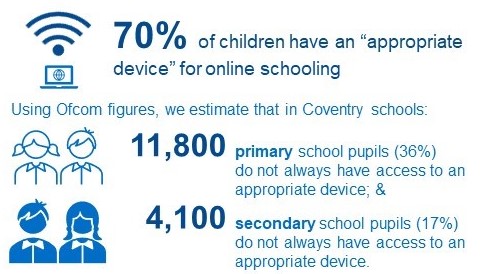Enhancing our digital offer
Digital inclusion and accessibility
For gigabit broadband coverage, Coventry is the top-ranked local authority in the West Midlands region and is joint 2nd (with Derby) for all the UK. The telecoms regulator Ofcom measures access to, and the performance of, fixed broadband and the mobile network in its Connected Nations reports.
As of January 2022, gigabit availability covered 94.8% of residential premises in Coventry with 91.9% covered by Full-Fibre, up from 91.5% and 75.4% respectfully in January 2021. Across the UK, 66% of homes can receive gigabit with 33% of homes able to receive Full-Fibre.
Furthermore, 99.5% of residential premises have access to decent fixed broadband - defined by the UK government as a data service that provides fixed download speeds of at least 10Mbit/s and upload speeds of at least 1Mbit/s.
According to Ofcom, the number of residential properties in Coventry in January 2022 was 142,295 with 142,132 matched to a broadband operator.
Overall, average download speeds have improved from 84.3Mbit/s in June 2020 to 106.2Mbit/s in May 2021 with speeds for those for lines 10<30Mbit/s lines increasing from 2.2Mbit/s to 18.3Mbit/s. Meanwhile, upload speeds have decreased from 15.4Mbit/s to 13.8Mbit/s overall and from 17.7Mbit/s to 2.3Mbit/s.
Decent broadband can also be accessed through the mobile network using 4G services. As of January 2022, 86.06% of all premises have a reliable signal for 4G services while indoors from all four network operators (EE, O2, Three & Vodafone), an increase from 83.06% in January 2021.
Digital exclusion
There is no single measure of digital exclusion, however it is possible to measure the risk, or likelihood, of digital exclusion using the Digital Exclusion Risk Index (DERI) tool. DERI, developed by Greater Manchester Combined Authority, visualises the likelihood of digital exclusion for every LSOA (Layer Super Output Area) in England and Wales and every data zone in Scotland.
The tool brings together a broad set of metrics to create an overall DERI score for each area where 0 represents a low risk of exclusion and 10 a high risk. The metrics included are the proportion of the population over 65, Ofcom’s broadband coverage and performance, the unemployment rate, the index of multiple derivation, qualification levels, pension credit claimants, long-term health problems or disabilities, and social gradings.
Coventry’s DERI scores range from 6.12 in the Manor Farm LSOA area to 1.36 in the Gosford and Gulson Roads LSOA. Its average score is 3.44. Compared to its local peers – West Midlands Combined Authority (WMCA) and Coventry and Warwickshire Local Enterprise Partnership (CWLEP) – Coventry is below each peer’s average of 3.55 and 3.59 respectfully. This ranks Coventry as the 3rd least excluded within the CWLEP and 2nd least in WMCA. Further afield, the average within England’s Metropolitan Districts and the CIPFA local authority grouping is 3.53 and 3.51.
Internet user classification
In the latest available dataset (2018), 147 of 195 LSOAs in Coventry are categorised in the lower half of the Internet User Classification scale (out of 10). The largest group by LSOA (57) are classified as passive and uncommitted users; rank 7. These users have limited or no interaction with the internet and tend to reside outside of city centres and close to suburbs or semi-rural areas.
The second largest user group is e-Mainstream (49 LSOAs); rank 6. These users exhibit typical internet user characteristics in heterogeneous neighbourhoods at the periphery of urban areas or in transitional neighbourhoods.
The third largest user group (29 LSOAs) are classified as e-Withdrawn; rank 10. These are the least engaged users and are in deprived urban areas with higher rates of unemployment and social housing. They also have the lowest rate of internet access via a mobile device.
In comparison, the top three user groups by LSOA in Warwickshire are e-Rational Utilitarians (rank 5), passive and uncommitted users (rank 7), and e-Mainstream (rank 6).
Children’s digital accessibility
According to Ofcom’s 2022 Children and parents: media use and attitudes report, 99% of UK households with children aged 0-17 had internet access and used it in the home, with 70% of children, defined by their parents, having access all the time to devices appropriate for online schooling.
However, 36% of parents nationally said their primary school-age children did not always have access to such a device in the home with 17% saying the same for secondary school-age children; approximately 11,800 and 4,100 pupils in state-funded Coventry schools respectively in 2021/22 based on Department of Education headcount.
The most-cited devices used to go online by 3-17-year-olds were mobile phones (72%) and tablets (69%) with 43% saying they used any device other than a laptop, netbook, or desktop to go online; translating to about 26,100 of pupils in state-funded Coventry schools who do not use a laptop, netbook or desktop computer to go online - based on the Department of Education’s headcount of all state-funded pupils (aged 3-19) in Coventry.
Increase in self-service transactions
In 2020/21 there were 352,751 transactions completed through self-service channels which increased to 415,254 transactions in 2021/22. This increase relates to the introduction of the tip booking process to manage visits during the pandemic. There has been some additional take up of self-serve because of the pandemic, though this has been limited. The intention in the longer term is to revisit our online offerings and incorporate user feedback to ensure that services are simple and easy to interact with.



